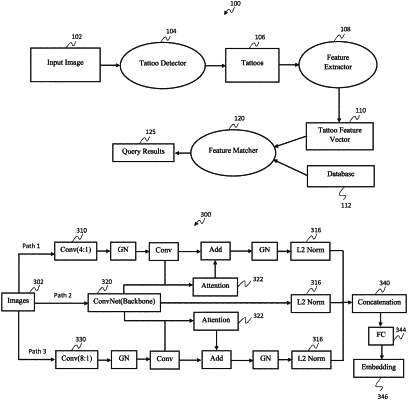| CPC G06V 20/52 (2022.01) [G06F 18/211 (2023.01); G06F 18/214 (2023.01); G06N 3/08 (2013.01); G06V 20/41 (2022.01)] | 20 Claims |

|
1. A computer-implemented method executed by at least one processor for detecting tattoos on a human body, the method comprising:
inputting a plurality of images into a tattoo detector;
selecting one or more images of the plurality of images including tattoos on a human body;
extracting, via a feature extractor, tattoo feature vectors from the tattoos found in the one or more images of the plurality of images including tattoos on the human body;
applying a deep learning tattoo matching model to determine potential matches between the tattoo feature vectors and preexisting tattoo images stored in a tattoo training database, the deep learning tattoo matching model having three paths for each image of the plurality of images input into the tattoo detector, the first path including a Conv(4:1) branch, the second path including a ConvNet branch with two attention mechanisms, and the third path including a Conv(8:1) branch, where each path provides for a single L2 Norm directly before concatenation is performed; and
generating a similarity score between the tattoo feature vectors and one or more of the preexisting tattoo images on the human body stored in the tattoo training database to identity a person by a soft biometric trait.
|